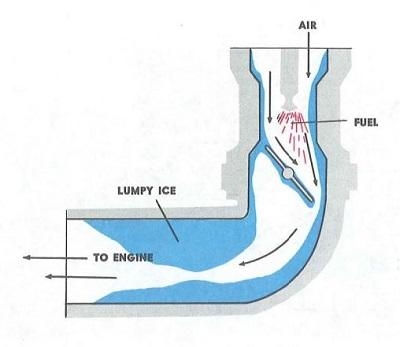Carburetor Ice Is An Invisible Menace That Can Catch A Pilot By Surprise
Our primary flight instructors have drilled into us that carburetor ice can occur even in the hottest months, but the pilot of a Cessna 172 flying along Florida's Riviera Beach last August apparently forgot that lesson.

In this NTSB report, the pilot was not flying in winter conditions and was caught by surprise when carburetor ice caused him to make a forced landing. While this report was about warm weather carburetor ice, in the winter we have to be even more careful.
Carburetor icing occurs when there is humid air, and the temperature drop in the venturi causes the water vapor to freeze. The venturi effect can drop the ambient air temperature by 30-40 degrees F, therefore carburetor ice often occurs when the outside air temperature is in the 60-70 degree F range.
The problem we run into is that it is commonly taught to apply carb heat prior to reducing power, which can give the false impression that carburetor ice is only a concern with reduced power. That’s simply not the case. The only reason reduced power leads to a greater susceptibility to carburetor ice is that the throttle valve position presents more area for the ice to accumulate on.
The fact is, carburetor ice can form at any power setting. If an engine is running rough the application of carb heat should be a checklist memory item regardless of what configuration the aircraft is in. Remember, if carburetor ice is present, the application of carb heat will cause the engine to run quite badly as the ice turns to water and is ingested into the induction system. In other words, you’ll definitely get a heart rate test, but hang in there; it will get better.
Here’s a few of hints that we have received from expert pilots regarding ways to protect yourself from carburetor icing.
Carburetor ice can form while taxing and be a major problem on takeoff. If the conditions are conducive to carburetor icing there’s nothing wrong with taxing with the carb heat on. However you may want to lean out the mixture just a bit as the warm air causes the engine to run rich.
Another consideration is to make sure there is no carburetor ice prior to taking off. One instructor we know recommends that after pulling on the runway, hold the brakes and go to about half power and apply the carb heat for about five seconds before going to takeoff power. Another way to do this would be to simply apply full throttle with the carb heat on, and as the airplane accelerates shut the carb heat off.
When in a gliding approach to landing, apply the carb heat, and be sure to clear the engine occasionally by running the power up. This is particularly important on aircraft with lightweight propellers made of wood or carbon fiber.
If an engine starts running rough or losing power at any time, go for the carb heat. Remember, if the engine quits because of carburetor ice, it’s too late for carb heat. Applying unneeded carb heat will make the engine run a bit rich (lean out the mixture) but it will not hurt anything.
Don’t let carburetor ice ruin your flying day.
(Image from AC 00-6a, Aviation Weather)
 Classic Aero-TV: In Praise of Alabamas Patriot Aircraft USA
Classic Aero-TV: In Praise of Alabamas Patriot Aircraft USA NTSB Final Report: Cirrus Design Corp SR22
NTSB Final Report: Cirrus Design Corp SR22 ANN's Daily Aero-Term (12.21.25): Dead Reckoning
ANN's Daily Aero-Term (12.21.25): Dead Reckoning ANN's Daily Aero-Linx (12.21.25)
ANN's Daily Aero-Linx (12.21.25) Aero-News: Quote of the Day (12.21.25)
Aero-News: Quote of the Day (12.21.25)



